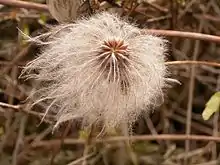| Clematis serratifolia | |
|---|---|
.jpg.webp) | |
| Twining on a fence | |
 | |
| Seedhead | |
| Scientific classification | |
| Kingdom: | Plantae |
| Clade: | Tracheophytes |
| Clade: | Angiosperms |
| Clade: | Eudicots |
| Order: | Ranunculales |
| Family: | Ranunculaceae |
| Genus: | Clematis |
| Species: | C. serratifolia |
| Binomial name | |
| Clematis serratifolia | |
| Synonyms[1] | |
|
List
| |
Clematis serratifolia, the Korean clematis, is a species of flowering plant in the family Ranunculaceae, native to Khabarovsk and Primorsky Krais of the Russian Far East, Manchuria, and the Korean Peninsula.[1][2] A deciduous climber reaching 3 to 4 m (10 to 13 ft), in the wild it is often found growing in calcareous soils, but can handle acidic soil as well. As an ornamental it is grown for its citrus-like floral aroma and its fluffy seedheads, and is recommended for courtyards, walls, borders, and the like.[3][2]
References
- 1 2 "Clematis serratifolia Rehder". Plants of the World Online. Royal Botanic Gardens, Kew. Retrieved 28 January 2023.
- 1 2 "Clematis serratifolia Korean clematis". The Royal Horticultural Society. 2023. Retrieved 28 January 2023.
4 suppliers
- ↑ Fern, Ken (12 October 2022). "Useful Temperate Plants Clematis serratifolia Rehder Ranunculaceae". temperate.theferns.info. Temperate Plants Database. Retrieved 28 January 2023.
This article is issued from Wikipedia. The text is licensed under Creative Commons - Attribution - Sharealike. Additional terms may apply for the media files.